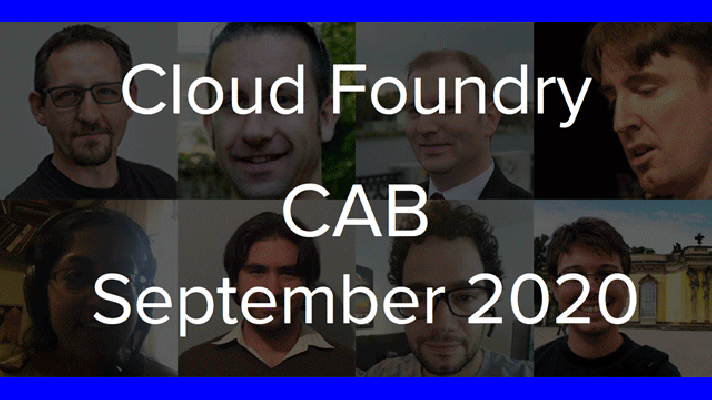Recap: Cloud Foundry Summit North America 2015, Day 2
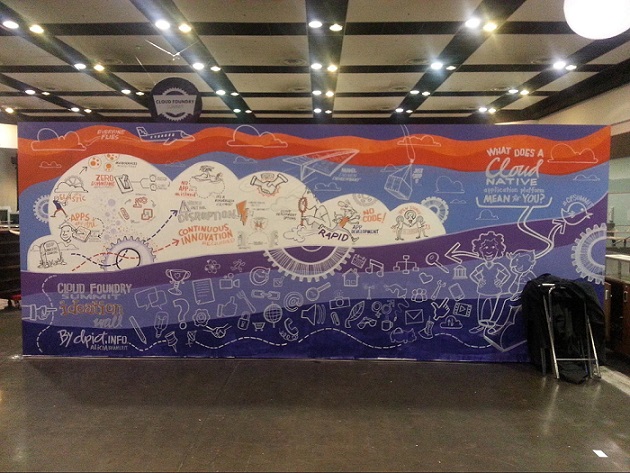
According to Diego Lapiduz—who presented at the CF Summit on Monday—one of his colleagues recently said: “If you take Cloud Foundry from us, we will hurt you.” Quite convincing to hear this from anyone working within US GSA! Still, every joke has its share of truth. Those who work with Cloud Foundry become its advocates. The keynotes and sessions delivered on the 2nd day proved that once again.
Keynotes
Pivotal: Welcome to the cloud-native enterprise!
Some people say that PaaS (and Cloud Foundry in particular) may not be ready for the enterprise, or not ready for production, or only useful to the likes of Uber. The first keynote by James Watters and Joshua McKenty of Pivotal dispelled these assumptions.
One of the main points was that a PaaS, such as CF, changes the way organizations are operating. If you have cloud-native apps on a PaaS, you are probably getting them to production almost immediately. Guys like Uber and Netflix were early adopters out of necessity.
In James’s view, “Google and Netflix are not different, they’re the future.” It seems that Joshua couldn’t agree more as he developed the idea further: “The equivalent to going to college today is working at Google.” These companies set an example to government agencies that go agile and it still takes them nine months to deploy new apps.
According to Joshua, “native cloud is the means of binding.” Still, he says that most people only equal cloud-native to 12-factor, while you can actually go beyond this.
Afterwards, James spoke about WebSphere and WebLogic and how they should move to Spring. He also revealed that Spring Boot passed 1 million downloads by April.
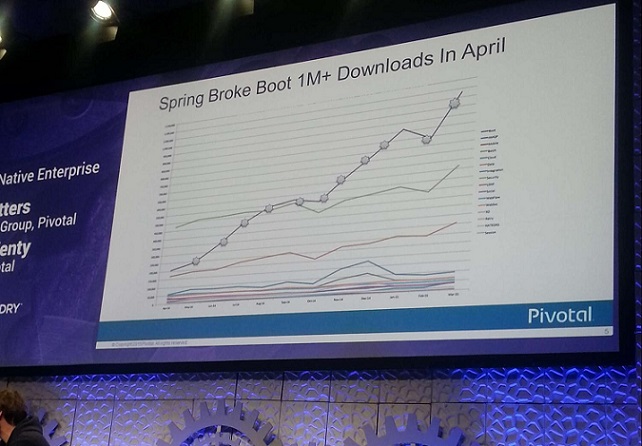
In general, this talk was penetrated with the idea of changing the world. Thus, James and Joshua outlined a future where developers and DevOps unite to create distributed solutions with multiple devices to bring along the changes for the better.
Huawei: Communication as a Service with Cloud Foundry
The opening talks were continued by Huawei, a long-time telecom company that bet its future on PaaS, SDN, and NFV. Dr. Ying Xiong, Chief Architect for Base Platform Service, spoke about how Huawei is using Cloud Foundry and APIs for rapid app development in their “mushroom cloud.”
The talk uncovered some details about the company’s internal Cloud Foundry deployment, which is currently running 4,800+ applications and has 3,500+ registered users.
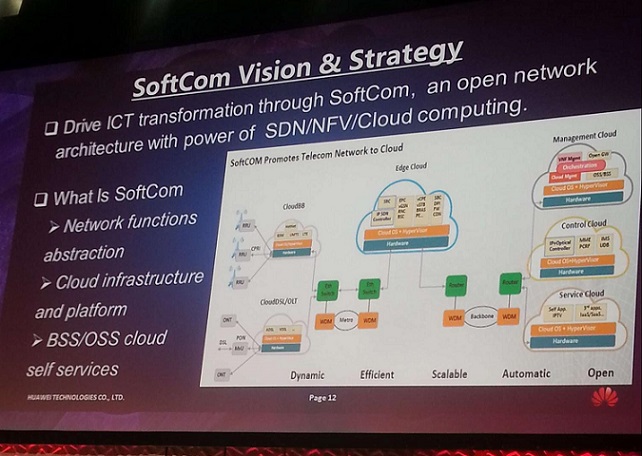
Dr. Ying Xiong also shared what challenges they had to overcome. For instance, dealing with an open API, working with a large cluster in a public cloud, etc. In addition, he gave a couple of examples of app apps they are running on a PaaS.
VMware: Enabling the developer to be a first-class user of a data center
Kit Colbert of VMware presented a keynote on security and making data centers more developer-friendly. According to him, “the biggest threat to security is internal employees.” On the other hand, “most people’s iPhone is more secure than most data centers,” said Kit.
Humana: Consumerizing healthcare through Lean and Agile digital product dev
Health insurance giant Humana wrapped up the morning keynotes. Jason McKee and Antonio Melo described how the company had to change their old ways and reinvent themselves—faced by fierce competition. Today, “Healthcare is on fire!” noted Jason McKee.
They shared a story of using Cloud Foundry for developing and deploying an app for everyone in as little as five weeks. Humana’s platform is based on Pivotal tools: Pivotal Tracker is used for project management and Dashing.io powers the dashboard.
EMC: Not all clouds are created equal
Brian Gallagher of EMC began by explaining why it is important to use the right type of cloud for running your apps. In his opinion, this cloud diversity is one of the reasons CF appeared. So, “make sure you $ cf push my-app to a good cloud!” suggested Brian.
Lockheed Martin: Managing cultural transformation
Then, Lockheed Martin’s team discussed the details of their journey to the DevOps culture. The aerospace, defense, and security company used Cloud Foundry to improve efficiency and process big data. “We had to transform our IT, processes, and people.”
They are using the Pivotal CF distribution. At first, the capabilities promised by Cloud Foundry sounded too good to be true, but it totally managed to deliver on all of them. According to the team members—Kevin Carlson, Christine Chesnik, and Cecil Miller—the key to success with a PaaS is bringing together the four Ps: people, process, platform, and prediction.
GE: Cloud Foundry for the Internet of (really important) Things
GE, which announced the launch of its own Industrial CF Dojo on Monday, spoke of using Cloud Foundry for IoT applications. “Maybe you think this is like cropdusters coming to an organic growers conf. Let me convince you otherwise,” started his talk Harel Kodesh, GE’s VP/CTO.
According to him, a single flight generates 500 GB worth of data. So, if you have 100,000 flights a day, there are a whopping 50 petabytes to store and process every 24 hours. The keynote described how GE handles all this data using a PaaS. We all were impressed with how GE runs the cf push wind-turbine command.
Another point made by GE Software is securing the Industrial Internet. Atul Kshirsagar, Sr. Engineer at GE, outlined the company’s vision on the topic, involving the use of DDS at the top layer of a securitization strategy. Watch his slides for more.
Cory Doctorow: Why the opposite of “free” is “slave”
The final keynote of the summit—funny, as well—was presented by Cory Doctorow, an author, a blogger, and a journalist.
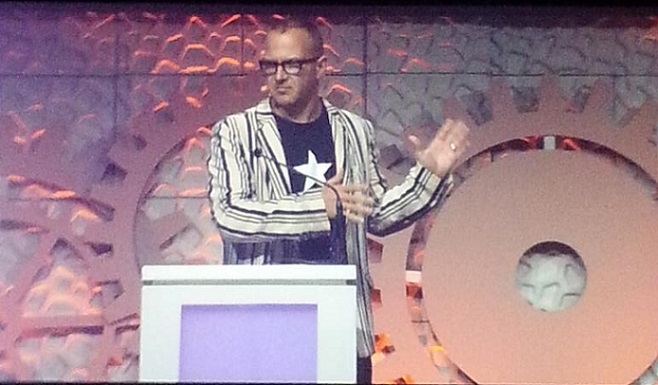
“The plane I’m taking to London is a flying Solaris workstation.” —Cory Doctorow
Sessions
IBM + Pivotal: BOSH bootstrapping
During this session, Michael Maximilien of IBM and Maria Shaldibina of Pivotal talked about external CPIs for BOSH, which are now distributed as releases. Highlights:
- There is no need to fork BOSH any more (well, almost).
- CPIs are now separately versioned and maintained.
- This allows for better team separation and growth.
- It also allows to use non-Ruby programming languages.
- External CPI got better at including CPI dependencies.
Lessons learned from Corelogic’s year of Agile development with CF
In this session, Richard Leurig provided a glimpse into how Agile development works with Cloud Foundry at CoreLogic. The main positive aspects he named were:
- easy deployment and scaling of apps
- configurability and support for many frameworks, including your own
- simple upgrades
- integration with Splunk and AppDynamics
- easy to lookup app logs: “as simple as
cf logs myapp” - great support from the Pivotal CF team
On the downside, he mentioned some things that could be improved:
- Resiliency and recoverabilit.
- The health dashboard.
- It would be great to have tools to support operational efficiency.
- Backups are still manual and need to be done frequently.
- Role-based controls could be finer grain.
- There is a possibility of credentials stored in environment variables showing up in third-party tools and integrations.
EMC: CF and the 12-factor app 101
Raghavan Srinivas and Matt Cowger of EMC presented their session for operations engineers, “The Secret Decoder Ring for Operations.”
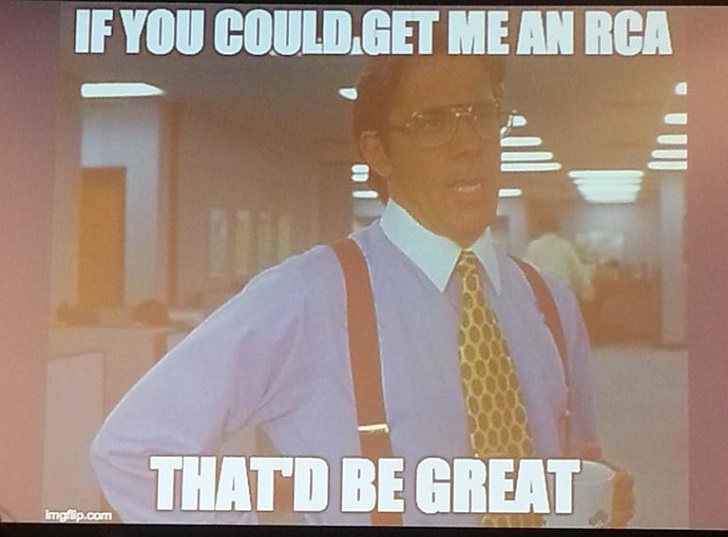
The goal was to cover the main concepts and principles of the 12-factor methodology to help Ops better understand the Devs community.
LDS Church: Norouter—running Cloud Foundry without the Gorouter
Mike Heath of the LDS Church introduced Norouter, an open-source alternative to the Cloud Foundry’s Gorouter. The thing is that the Gorouter with its two layers of load balancing imposes a number of issues. The Norouter solution, in its turn, is supposed to integrate directly with existing load balancers, eliminating the need to forward traffic through the Gorouter.
It is a BOSH deployable agent that collects route data in the same way as the Gorouter does and dynamically updates LTM. At the moment, Norouter is in the beta quality.
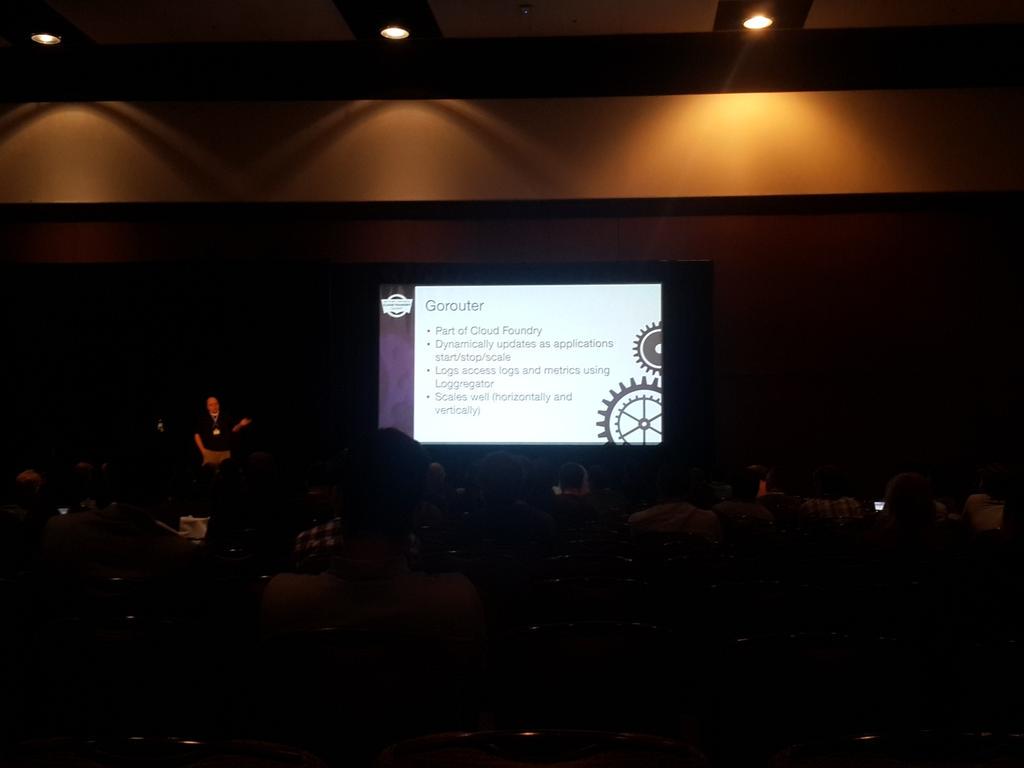
Mike demonstrated how the LDS Church implemented this solution within their organization’s F5 Local Traffic Managers.
The start of Kroger’s journey to Cloud Foundry
Kroger, the second largest retailer in the United States, presented their story of how they started using Cloud Foundry. According to the speakers, James Masters and Ted Tollefson, the main goals with CF were to consolidate platforms, achieve elastic scaling and automation, as well as improve quality. They used a combination of code, tools, and environments to automate project provisioning. Liked this quotation: “It’s not about day 1 deployment, it’s about day 2 ongoing management.”
Matt Stine: Deploying Microservices to Cloud Foundry
Matt Stine of Pivotal delivered another great talk on microservices and how they work with Cloud Foundry. This was probably one of the most anticipated sessions, so the room was full to its capacity. Some people were even sitting right on the floor!
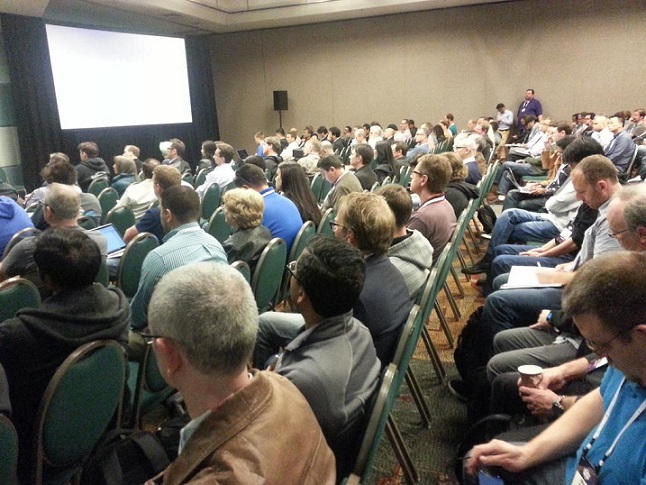
“BOSH all the things!” —Matt Stine (Pivotal)
According to Matt, many assume that the word “micro” means small and that is the case. In reality, it is not quite the point. Matt insists that you cannot really measure something as complex as microservices. To understand them, you should think of SOA and loose coupling. Furthermore, Matt emphasized that one should become an expert at monoliths before learning how to manage microservices.
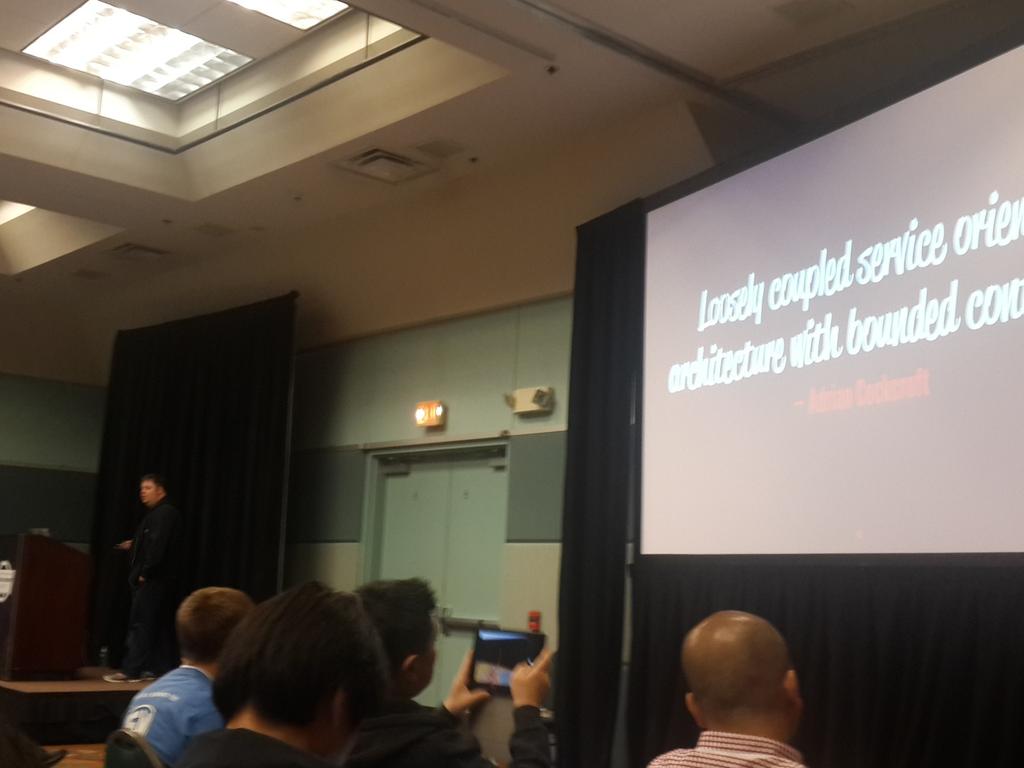
“No microservice is an island.” —Matt Stine (Pivotal)
Matt also covered some challenges of distributed systems to meet:
- configuration management
- service registration and discovery
- routing and load balancing
- fault tolerance
- monitoring
For those who couldn’t attend, Matt shared a one-hour version of his 30-min talk on microservices at the SV CF meetup the next day.
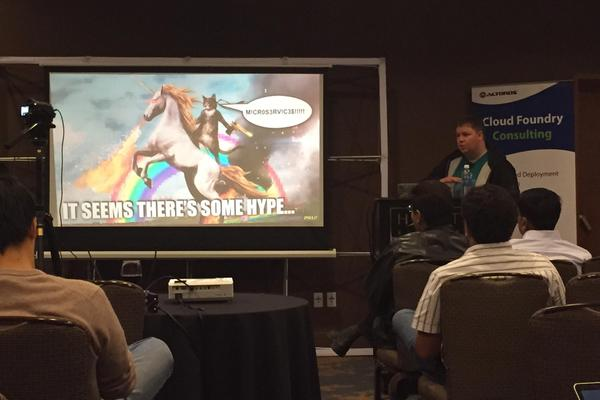
He already shared his preso online.
CenturyLink: Making the leap by transitioning enterprises to a PaaS mindset
Richard Seroter of CenturyLink spoke about the challenges that transitioning to a PaaS entails and how to ease this process. His main point is that the change is extremely difficult. To become successful with Cloud Foundry, you have to make cultural transformation within your organization. “PaaS is a change in mindset for the enterprise,” said Richard.
Therefore, he provided some tips for CF adopters:
- Creating reference architectures is always a good idea.
- To become productive, the company needs to focus on the problem.
- Testing disaster recovery is also very useful.
- If you haven’t moved your data to the apps, you haven’t really adopted CF.
- Try smaller things in a public cloud and see if it’s a right fit.
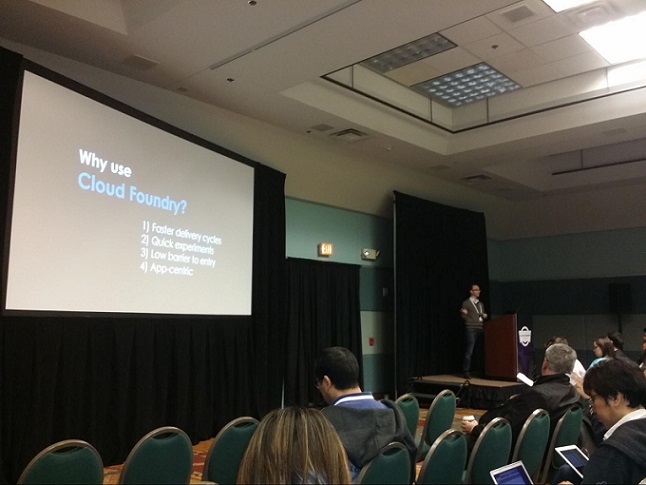
“I’ve patched and updated pieces of the app and now it’s a snowflake I can’t destroy.” —Richard Seroter
IBM: Migrating the Bluemix UI to a microservices architecture on CF
This session by Tony Erwin and Brian Martin described how IBM, which is currently working to get context path routing and app versioning into Cloud Foundry, had migrated the Bluemix UI to a microservices architecture.
The Bluemix customer UI used to be itself a monolith app running on CF. Its goal was to provide a desktop-like experience in a browser. By turning it into a microservices-based app, IBM managed to:
- aid migration to a lighter, modern technology stack
- improve speed by using smaller services
- make life easier for developers
- make it possible to do regular updates to the UI
- improve SEO
- improve cross-team UI consistency
Future iterations: “driven by 12 factors!”
Concourse: CI that scales with your project
While not working on Cloud Foundry yet, Alex Suraci built the Concourse project to address the needs of developers who were creating CF. The concept of simplicity is the essence of the project: simple ideas and tools. So, that’s what Concourse offers:
- expressing entire pipelines
- integrating with arbitrary resources
- executing one-off builds (either locally or in another CI system)
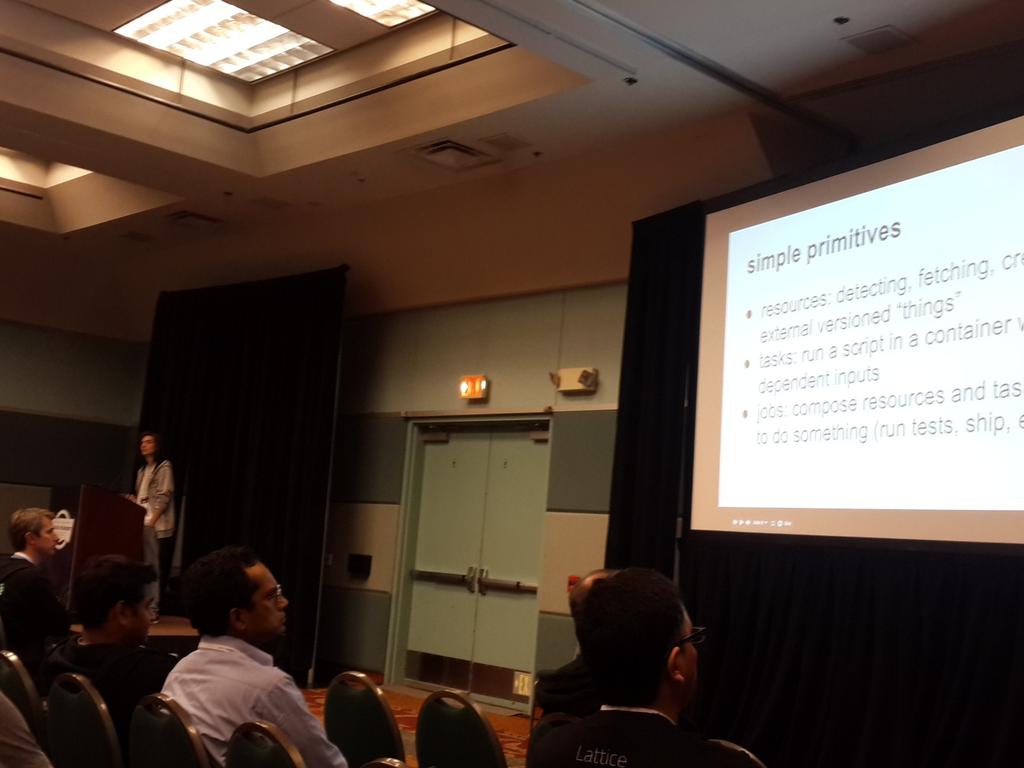
“Read the release notes if you want to live.” —Alex Suraci (Pivotal)
The Concourse CI system is deployed and configured with BOSH and leverages Garden for containerization across platforms. Alex covered what shortcomings of other CI systems his pet project addresses and how the Diego team uses it.
CloudSoft: The Apache Brooklyn service broker and plug-in
Incubation of the Apache Brooklyn service broker was recently approved by the services PMC. Alex Heneveld and Robert Moss of CloudSoft explained why one should care about Apache Brooklyn and how it is bridged with Cloud Foundry: “It expands your world without compromising it.”
In short, by using Apache Brooklyn with Cloud Foundry, engineers can:
- access the 40+ services in its catalog
- access the Brooklyn ecosystem blueprints
- add new services to CF with just a yaml blueprint
- deploy services very fast with Clocker.io
- add management policies to services
Altoros: The metrics for quantifying the value of Cloud Foundry
According to Peter Drucker, if you cannot measure something, you cannot control or manage it. Measuring the value provided by your PaaS is the only way to get hard data to win over your teams, management, and other stakeholders. The talk by Andrei Yurkevich of Altoros offered some insights into how this can be done and where to begin.
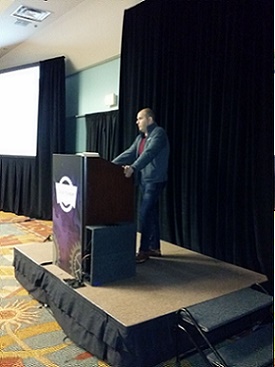
Andrei noted that engineers need Cloud Foundry metrics in order to make decisions, set cleas goals, evaluate alternatives, convince managers and colleagues, track progress, and get feedback. According to him, the easiest things to measure are:
- the cost of implementation
- the cost of support
- time to production
Some other productivity metrics to measure:
- operational efficiency
- hardware utilization
- high availability
- service quality
- developer productivity
- IaaS lock-in
Other things that can be quantified with less precision include customer and employee satisfaction, losses due to outages, management overhead, etc.
#CF metrics for productivity. #altoros #cfsummit pic.twitter.com/qxllTMwieq
— Shyam Varan Nath (@shyamvaran) May 12, 2015
In his talk, Andrei gave an example of how timing differs when bringing a system to production with Cloud Foundry vs. alternative solutions.
#CF and traditional approach. #cfsummit pic.twitter.com/SWzBHr7GyB
— Shyam Varan Nath (@shyamvaran) May 12, 2015
He elaborated on timelines for infrastructure provisioning.
Calendar tome vs productive time for #infrastructure. #cfsummit pic.twitter.com/bvig4lGpCB
— Shyam Varan Nath (@shyamvaran) May 12, 2015
Andrei also enlisted six reasons why one should need Cloud Foundry:
- decrease time to production
- iterate faster
- increase productivity of developers
- improve quality of products
- improve efficiency of IT operations
- increase utilization of hardware
And additional bonuses Cloud Foundry brings:
- employee satisfaction
- customer satisfaction
- collaboration between developers and IT
- lower management overhead
- easy initiation of a project

Thanks to everyone who managed to attend, especially to Shyam Varan Nath of GE who provided a very detailed Twitter stream during the session.
IBM: Finding and organizing a great Cloud Foundry user group
Daniel Krook, Manuel Silveyra, and Animesh Singh of IBM delivered a nice overview of how to organize a successful Cloud Foundry user group. The bottom line is that to hold a really great meetup, you need to:
- provide great content
- invite relevant and respected speakers
- find a great venue
- get people to attend your meetup
Animesh Singh suggested: “Build content in a way that it can continue living after your meetup.” The full presentation is already available:
Here, we wanted to note that Altoros contributed to organizing 50+ of these global Cloud Foundry events during the last two years. Thanks to Animesh and Daniel for putting us on several slides and for the great work we did together in 2014–2015.
For 2015, our team has already scheduled a variety of hands-on training classes and meetups in different US cities. We’d be glad to see you there, if you want to learn something new about Cloud Foundry.
More fun than ever
The second day seemed even more packed with valuable information and pure fun than the previous one. There were plenty of opportunities for entertainment, including virtual reality, Pac-Man, Guitar Hero, ping pong, Monopoly, and much more.

They say, it’s better to build bridges instead of walls. The summit experience proved that you just need to build the right walls to connect the community.
The so-called “Ideation Wall” was a good indicator for what bothers developers, what they strive for and up to. That is how the wall looked like at the the summit wrap-up:

There was also a hand-made job board where companies could place their open vacancies. According to it, almost everyone was hiring.
Our friends at Pivotal were also busy all day long—with painting a wall of their own. In its turn, HP Dev Platform gave away their wall for people to write down their technologies of choice.
Afterword
Cloud Foundry has gained momentum. Each day now brings new announcements, releases, contributions, meetups, partnerships, Dojos, etc.
For instance, the next day after the summit, it was announced that the J.P. Morgan bank has also joined the Cloud Foundry Foundation. Congrats and welcome, it is a good addition to other 40+ members!
Today (May 14), Dell expanded its Digital Business Services portfolio to include cloud-application services that leverage Pivotal CF, and more to come.
Luckily, 64 video recs from the summit has just been uploaded by the organizers. We’re already missing all of you, this was the best CF event so far!
All recaps: Day 1 | Day 2 | Top 100 Quotes
*All photos are courtesy of Altoros.



